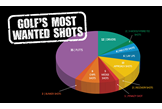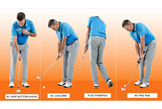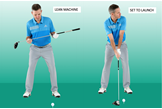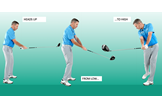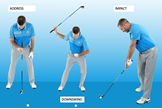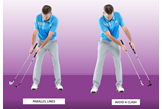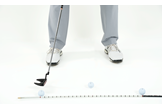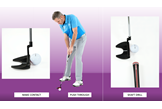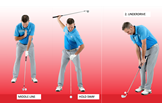Instruction: Master Golf’s most valuable shots
Published: Last updated:
Golf’s Most Wanted Shots: Improve your score by using these drills to master the most common shots you face on the course
Mastery of the downhill bunker shot off one knee is no doubt impressive – but let’s face it, it’s not that valuable. To score better, you need to excel at the shots you face most often. But how do you know which they are?
Well, we know thanks to Shot Scope, an innovative shot tracker that sends data through a sensor in the butt of the club to a wrist-worn device. Shot Scope has data on some 14 million shots, played by ordinary club golfers like you and me over 320,000 rounds. It’s allowed analyst Gavin Dear to compile a clear picture of which types of shots are played most often, and so where we need to target our work and practice. Below, you will learn how the average round is compiled, and its six most common and valuable shots.
From here, TG Top 50 teacher Darren Parris will take you through each one, giving you drills to improve. Prioritise these parts of your game – it’s your quickest route to lower scores.
85: HOW AN AVERAGE ROUND IS COMPILED
Whatever your handicap, most club golfers can relate to a round in the mid-80s, says Shot Scope – and this is a breaks down of how that is compiled.
Arguably most surprising is the number of bunker shots – just two. While a sound bunker game is, of course, a plus, its importance in your final score perhaps gets a little inflated.
Naturally, putting is the clear leader in shots played, with 41% of the round taking place on the green. That’s why this feature covers both long and short putts. But elsewhere, your most common shots are driver off the tee, longer approaches, wedge approaches and greenside chips. We’ll look at these in more detail before TG Top 50 teacher Darren Parris helps you improve your performance in each of these key areas.
12 Drivers | 2 3-Wood/Hybrid tee shots | 4 Par-3 tee shots | 6 lay-ups | 10 approaches | 5 wedge shots | 6 chip shots | 35 putts | 2 bunker shots | 2 recovery shots | 1 penalty shot
#1 | Driver: 12 Shots
Gavin Says: “On average, a golfer hits 12 driver tee shots per round. Shot scope data clearly shows the value of distance with a driver. Hitting the ball further reduces the distance of the second shot which, in turn, cuts average proximity to the hole. That results in a significant scoring improvement.”
Handicap 8 | Fairways Hit in Reg (driver) 52%
Handicap 14 | Fairways Hit in Reg (driver) 46%
Handicap 20 | Fairways Hit in Reg (driver) 41%
Drive It Further: Shot scope stats illustrate how, as long as we are not hacking out sideways, a longer tee shot leads to lower scores. However, many club golfers never give themselves a chance to reach their distance potential. Here, we will look at how to adjust your set-up and swing to unlock those extra yards.
1. SET-UP
Adjusting your address to allow fuller, freer movement and to promote a strong, high-launch/low-spin ball flight is perhaps the best way to pile on the yards.
Lean Machine
Your body sets a framework for the swing. The driver is the only club in the bag where we want to hit up on the ball, so our framework needs to promote that. start by taking a comfortable, wide stance – insteps under shoulders – and dropping your trailing shoulder until your upper body angles upwards, as shown.
Set To Launch
Now build your address around these body angles. check, in particular:
● your ball position is opposite your lead instep and ahead of your shirt buttons. It promotes a sweeping impact with the clubhead at the base of its arc.
● at least half of the ball is above the crown of your driver. a relatively high tee encourages that swept, upward delivery.
● your weight is around 50-50, or perhaps just favouring your back foot. The important thing is you do not lock muscles and joints up by loading either side.
● The clubshaft is horizontal, hands level with the clubface. The more the shaft angles back, the more downward you’ll hit.
● your grip pressure is relatively light. soft hands encourage the bigger, more powerful muscles of the core to drive the swing, as opposed to a weaker, arms-dominated action.
2. SWING
When it comes to distance, enemy no.1 for the club player is the out-to-in, slicing swing path. For starters, the glancing blow it gives the ball makes for poor energy transfer. But it also tends to promote a downward strike angle and heel contact, both of which sap yardage. so here is a drill that will help you feel a more powerful, in-to-out swing shape.
Heads Up
Take your normal driver address, but hold the club out in front of you, shaft pointing at your belt buckle. Picture the area either side of the club. swing the club in this position and you will appreciate how an out-to-in swing correlates to a high-to-low move through this horizontal impact position.
From Low…
so work on reversing that. swing the club, focusing on your throughswing only. Practise attacking the “ball” with the club working from low to high. Feel that, as the club approaches “impact”, it’s below that horizontal position.
… To High
Post-“impact”, allow your throughswing to continue its upward path, taking the clubhead above its address height. Train this low-to-high pattern for several swings, then take your regular address position and make a swing. you will feel the beginnings of a more in-to-out delivery path – the key to a more solid, powerful strike.

#2 | 170 – 120 yard Yard Approach
Gavin Says: “One of the most critical distances in golf, this shot covers par-3 tee shots, lay-ups and some fairway approaches. stats clearly show the benefits of using a hybrid, with a 14-handicapper finding the green 17% of the time as opposed to 11% with an iron. With average shots to finish the hole at 2.2 on the green and 3.5 off it, the benefits of becoming proficient with a hybrid are clear.”
Handicap 8 | GIR (Hybrid) 23% | GIR (Irons) 22%
Handicap 14 | GIR (Hybrid) 17% | GIR (Irons) 11%
Handicap 20 | GIR (Hybrid) 12% | GIR (Irons) 7%
STRIKE BETTER HYBRIDS: Perhaps the best way to understand how to get the most out of your hybrid is to set up like a fairway wood, but swing like an iron. That means an address position designed to encourage a fairly neutral, level strike, but an action that produces a slightly downward blow that compresses the ball. Follow these rules.
Address: Neutral Zone
Let a feeling of balance govern your set-up. Play the ball a couple of inches inside your lead heel – opposite your lead chest. Keep your weight 50-50 right-left and heel-toe, and avoid any major lean with your upper half – your shirt buttons should sit a little behind the ball. This address promotes a fairly level strike.
Downswing: Sequence To feel The Squeeze
Let a feeling of balance govern your set-up. Play the ball a couple of inches inside your lead heel – opposite your lead chest. Keep your weight 50-50 right-left and heel- toe, and avoid any major lean with your upper half – your shirt buttons should sit a little behind the ball. This address promotes a fairly level strike.
Impact: Brush The Turf
You’ll know you are moving in the right downswing sequence when:
1. Your lead hip clears easily as you approach impact, the natural result of the rotation primed by that downward, forward belt-buckle shift.
2. You create slight shaft lean at impact, the hands just beating the clubhead through the impact zone.
3. The clubhead sole brushes the grass after impact, the sign of an attack angle which is slightly downward but never steep.

#3 | Wedge Shots
Gavin Says: “On average, a round of 85 comprises at least five wedge shots, though some of the typical 10 approaches will also fall into this category. Our data shows that a 14-handicapper will hit the green less than half the time, with just 43% of shots finding the putting surface. The majority of misses come up short… and the higher the handicap, the more this is the case.”
Handicap 8 | % shots on the green 57% | % short 28%
Handicap 14 | % shots on the green 43% | % short 38%
Handicap 20 | % shots on the green 12% | % short 52%
SHARPEN YOUR WEDGE GAME: As shot scope shows, the cardinal error with pitch shots is coming up short. many club players throw the clubhead at the ball, adding loft to the face and producing high, directionless shots that inevitably don’t go the distance. Here are two ways you can re some purpose and penetration back into your wedge play.
1. Central Pivot
Turn on top of the ball to keep the flight dow
Middle Line
As soon as you fall behind the ball, the low point of the swing moves back and you’ll flick the ball up in the air. Guard against this by positioning the ball centrally in your stance and setting up with your shirt buttons opposite it.
Hold Sway
Throughout your backswing, make it your goal to keep that relationship intact; turn around a fixed point, making sure those shirt buttons don’t sway behind the ball. start down from here and it’s much easier to deliver a descending, driven blow with a stronger clubface.
2. Underdrive
The next time you practise wedge play, use your golf bag to wedge or prop up a horizontal cane or clubshaft a couple of feet in front of the ball, and a couple of feet above the ground. simply hit shots, trying to squeeze the ball under the cane. This will create the forward shaft lean that delofts the face and gives your shots a lower, stronger flight.
Strategy
It sounds too obvious, but when you don’t know how far your typical wedge shot flies it makes it a whole lot harder to hit the ball the right distance. With launch monitor coaching so readily available these days, there is no reason why you can’t get to the bottom of this, and give yourself some figures to work from. This is far more an investment than an expense.

#4 | GREENSIDE CHIPS
Gavin Says: “In an average round of 85 you will face six greenside chip shots. These are all within five or six feet of the putting surface, the kind of shot you face when your approach spills off the edge of the green. The average 14-handicapper typically gets these shots to within 9.2ft of the hole, so plenty of room for improvement. Pga Tour pros get up and down 90% of the time from these situations because they hit the correct short game shot; varying clubs, alongside a sound technique, is the way forward.”
IMPROVE YOUR CHIPPING
A straightforward chip shot demands an equally simple technique. amateurs mostly go wrong by overcomplicating the action, introducing excessive hand/wrist action that puts unnecessary energy and angles into the strike. Here are three easy ways to streamline your chipping stroke.
1. Use address to preset Impact
great chippers strike the ball with just a slight downward blow; it promotes a crisp, clean contact. But in trying to create this strike many club players overdo it, moving the ball back, leaning on to the lead foot and chopping down too steeply.
Shirt Buttons Ahead
Instead, preset the correct attack angle by playing the ball centrally, keeping your weight even and positioning your chest slightly forward. Picture pulling your shirt buttons towards the target until they are ahead of the ball. now you are set for that controlled, slightly downward delivery.
2. Lead arm/ Shaft Unit
To eliminate damaging wrist action, picture your lead arm and the club working as a unit. a great way to train this feeling is to place a cane or second club against the first as shown, so it extends up against your lead hip. as you swing back, maintain connection between the cane/shaft and the hip.
Flick Thwarted
Through the ball, any lower-hand flicking would send the clubhead pointing down towards the flag as the lead wrist breaks down. But with the cane/shaft in place, your lead hip becomes a natural barrier to this motion. your lead arm and shaft can get used to moving through as a uni ed hitting force, and that will add quality and consistency to your strike.
3. Reduce Grip Pressure
Take the headcover off one of your woods, and put it over the handle of your wedge. With the thick material between your hands and the club, it’s impossible to grip too tightly. make a few practice swings like this, and then hit the balls. Feel how a softer grip pacifies your hands and improves your feel of the clubhead
Free Ride
Gripping too tightly can feel like a way to immobilise your wrists, but it is poison for your chipping. not only does it hinder feel, it also compromises rhythm and leads directly to stiff, jerky movement. let your arms, chest and shoulders drive the motion, and feel your hands and the club go along for the ride.
Strategy
One final word on chipping. shot scope data clearly shows the bene ts of changing clubs around the green, and letting the different lofts do the work. To select the right club, picture every chip in terms of three points; the ball (a), an on-the-green landing spot (B) and the hole (c). The distance from B to C will dictate the club – as it gets shorter, the club must get more lofted.

#5 | FIRST PUTT
Gavin Says: “The first putt is crucial. usually, from an average of 19ft from the hole, the first putt determines whether you have a tap in, or work to do for the second putt. Hitting a good first putt can save you up to five shots a round by reducing the number of three-putts.”
IMPROVE YOUR PUTTING FROM DISTANCE
Of course, as the putt gets longer so does the stroke you need to make to generate the distance. The problem for many amateurs is they begin to look for this extra power by creating speed through the hands and wrists. This creates inconsistencies with path, attack angle and strike, which is why the typical error is to come up short. Here are three ways to create smoother stroke and a more solid strike.
1. Two-club drill
Even out the contribution of your lead and trail hands
Parallel Lines
Take your putter and your wedge. grip the first in your lead hand, the second in your trail hand. adopt your putting stance, keeping the two shafts parallel and a few inches apart. make a lengthy backswing with one goal only – to keep the shafts parallel.
Avoid a Clash
Now sweep the putter and wedge through to the nish. again, your sole objective is to keep the shaft angles matching. at first you could well nd the wedge shaft clashes into the putter shaft – a sure revealer of an overactive lower hand. But persevere and keeping the shafts parallel becomes easier.
Smoother Strike
When both hands are making a matching contribution to the force applied to the stroke, its arc becomes more consistent and your stroke gains a better rhythm. Both of those help you find the right part of the face more often. That means more predictable energy transfer, and ultimately better judgment of pace.

2. Target your Finish
Learn an easy way to keep your hands under control
Flipping Awful
It’s not hard to tell when a golfer overuses their trail hand. The telltale sign is the conclusion of the stroke; the lead wrist collapses and the putter head is way past the hands, its face looking at the sky. Work on this finishing position can have a truly positive e effective on what goes on earlier.
Dry Run
On your next long putt, make three practice strokes where you focus only on your finish. swing through to a positive full stop and hold the position for a couple of seconds. check the back of your lead hand and the putter face are pointing more at the hole and the angle in the back of your trail wrist is retained. On the stroke itself, simply focus on repeating this position

3. Take Control of Swing Length
Match up your backswing and follow through to regulate and control force
Speed Test
Harnessing the power of your putter becomes much harder when it is rapidly accelerating or decelerating. To create a more even stroke and control its speed, make sure your backswing and throughswing lengths broadly match
Pendulum Feel
Work on this by positioning two balls 18 inches or so apart, and then placing a third – your object ball, between them. swing back till the toe is opposite your back ball, then through till it’s opposite the front one. as you work on this, you feel a welcome pendulum quality entering your stroke… and the feeling the ball is coming o the face at a metered speed.
Strategy
Here’s a little mental trick. On your practice stroke, ‘feel’ the ball coming off the face exactly as you want, and say to yourself ‘That’s perfect.’ Your brain thinks you’ve already hits a great putt… and that puts you in your best possible frame of mind for the putt itself.

#6 | PUTTS INSIDE 4 FEET
Gavin Says: “In that round of 85 you will typically face 19 putts from inside 4ft. amazingly, one in ve of these – some 22% – are left short. as the graphic below shows, Tour pros hole 98% of these putts, while an average putter of a 14 handicap misses a little more than one in four. These short putts are unavoidable, so improving your performance here is one of the fastest ways to cut your score.”
| Average Round of 85 | Tour Pro | |
| Holed | 73% | 98% |
| Missed | 27% | 2% |
IMPROVE YOUR HOLING OUT
With the aim of the putter’s face contributing more than 90% to the ball’s starting direction on short putts, it’s inevitable that to improve your performance from 4ft and in, impact face aim becomes the key focus. Here are two simple ways to achieve this.
1. Push Drill
Learn where your blade is aiming
Make Contact
Head to the practice green. set up to a straight, short putt. address the ball normally, but position the putter so the blade is actually touching the back of the ball.
Push Through
Without any backswing at all, simply push the putter face through the ball. Without the time to make blade aim compensations, this pushing motion will show you exactly how you aim the blade at address. assess the result of the putt, and adjust the face aim until you can push it straight into the cup.

2. Shaft Drill
Train a squarer face at impact while allowing the stroke to flow
See Square
While a square face at impact is vital to holing out, trying too hard to deliver it can lead to issues of overcontrol and a lack of ow to the stroke. To beat this, simply practise with the ball next to the grip of an iron, positioned at right angles to the hole.
Perfect Match
The iron’s grip and shaft boosts your awareness of what square looks like. simply make your regular stroke, trying to match the blade’s angle to the clubshaft and grip through the ball. This helps you swing the putter through square, not to it, helping you train the face without manipulation.
Strategy
On short putts, always make it your business to pick a small, precise and clear target. This narrows your focus and keeps your mind clear… essential if you are to make a committed and free stroke.

